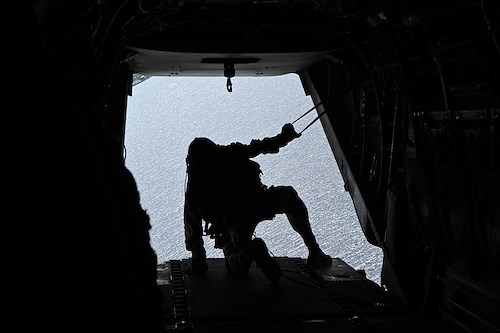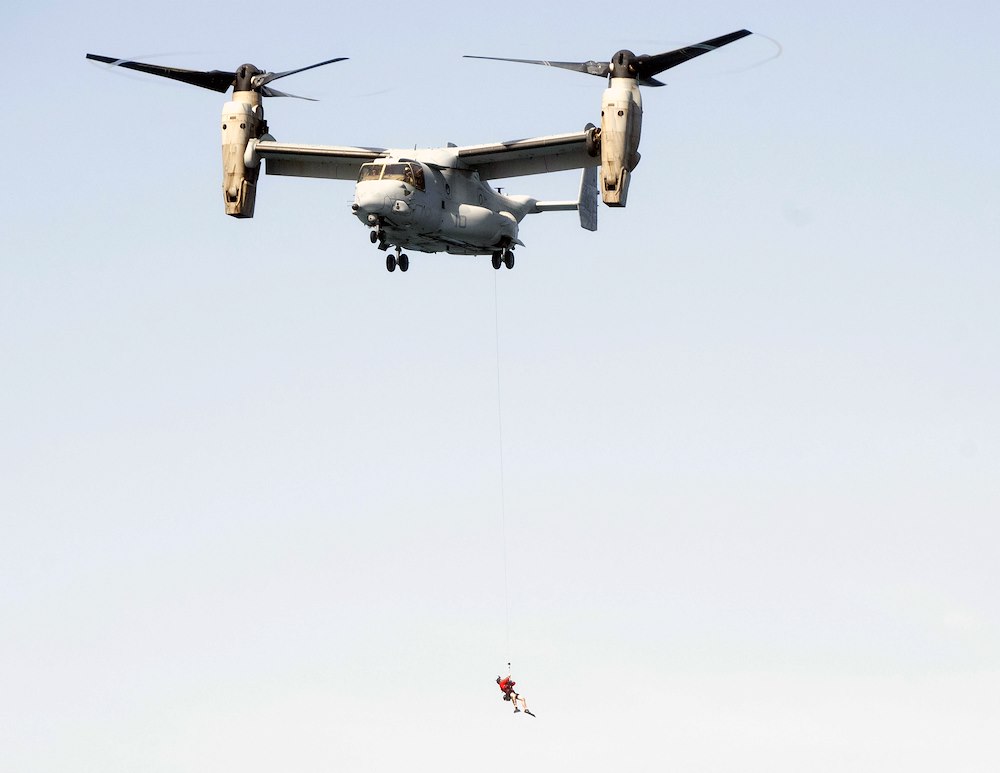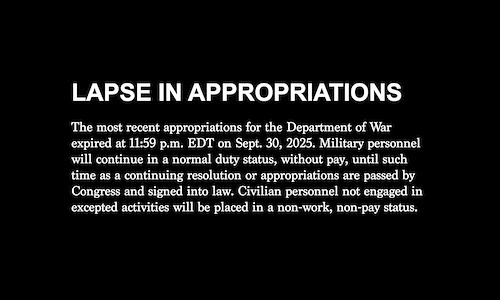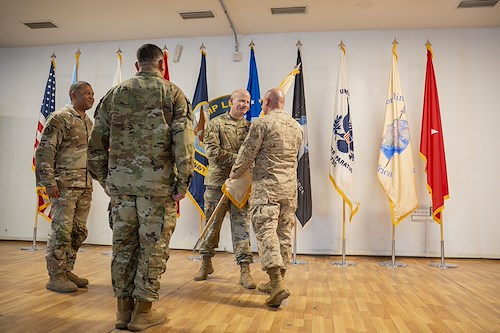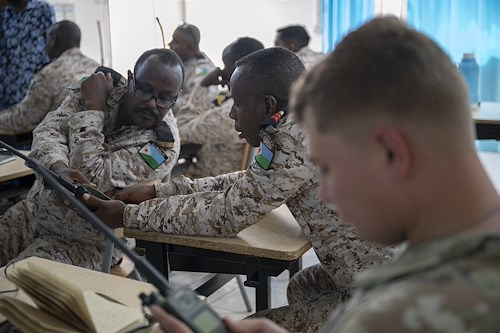Gallery contains 4 images
×
Photo 1 of 4
Combined Joint Task Force - Horn
A servicemember observes the activities of Exercise Bull Shark 24-2 over the Djiboutian coast line on May 5, 2024. The exercise allowed the multinational partners to test and improve communications and interoperability through knowledge exchange opportunities. (U.S. Air National Guard photo by SSgt Juan Paz)
Photo by: Staff Sgt. Juan Paz
Photo 2 of 4
Combined Joint Task Force - Horn
Exercise Bull Shark is a biannual personnel recovery exercise hosted by Combined Joint Task Force-Horn of Africa. The exercise enhances partnerships, reinforces crisis response capability for maritime, improved communications and shore personnel recovery in a combined joint environment.
Service members from the Combined Joint Task Force-Horn of Africa and Camp Lemonnier join the Djiboutian Coast Guard for a group photo after participating in Exercise Bull Shark 24-2, May 5, 2024. The exercise allowed the multinational partners to test and improve communications and interoperability through knowledge exchange opportunities.
Photo by: Senior Master Sgt. Shannon Niels
Photo 3 of 4
Combined Joint Task Force - Horn
Exercise Bull Shark is a biannual personnel recovery exercise hosted by Combined Joint Task Force-Horn of Africa. The exercise enhances partnerships, reinforces crisis response capability for maritime, improved communications and shore personnel recovery in a combined joint environment.
Service members from the Combined Joint Task Force-Horn of Africa and Camp Lemonnier join the Djiboutian Coast Guard for a group photo after participating in Exercise Bull Shark 24-2, May 5, 2024. The exercise allowed the multinational partners to test and improve communications and interoperability through knowledge exchange opportunities.
Photo by: Senior Master Sgt. Shannon Niels
Photo 4 of 4
Combined Joint Task Force - Horn
A Djibouti Coast Guard member prepares to repel from a MV-22 Osprey in support of Exercise Bull Shark 24-2. The exercise allowed the multinational partners to test and improve communications and interoperability through knowledge exchange opportunities. (U.S. Air National Guard photo by SSgt Juan Paz)
Photo by: Staff Sgt. Juan Paz
CAMP LEMONNIER, Djibouti (May 8, 2024) -- The Combined Joint Task Force – Horn of Africa, alongside Djiboutian, Spanish and French forces, collaborated for the semi-annual Bull Shark 24-2 exercise at Camp Doraleh and in the vicinity of the Arta Range, to strengthen communication and collaboration among international partners and allies on, May 5-6, 2024.
The objective of exercise Bull Shark 24-2 was to strategize, simulate, and carry out various personnel recovery scenarios involving land, sea, and air units, while ensuring effective communication among all participants. These included multiple branches of the U.S. military, Spanish Navy, French Force, Armed Forces of Djibouti, Bataillon d’intervention rapide, Djiboutian Navy, and the Djiboutian Coast Guard.
“During crisis response, time is of the essence,” said U.S. Army Col. Don Makay CJTF-HOA exercise director. “The delay or gaps in communication can cause significant delays which can lead to casualties.”
The exercise required complex multinational logistical coordination to ensure the mission objectives were accomplished while maneuvering safely. Training together as a combined joint force is vital for understanding how each element operates.
“Working with our partners is absolutely imperative,” said U.S. Army Capt. Robert Anthony Kawczynski, CJTF - HOA exercise planner. “It is important that we are able to communicate with our partners, build the team, fight and execute personal recovery and crisis response at a moment's notice.”
On day one, a maritime rescue was simulated, where Pararescue Personnel from the 82nd Expeditionary Rescue Squadron performed the extraction of personnel from water while effectively communicating with the Joint Personnel Recovery Center, the Djiboutian Navy, Djiboutian Coast Guard, and the Spanish Navy Frigate Canarias.
“It was great to work with all these nations, we were able to interact, have good communication, and share our procedures so we could accomplish the same mission,” said a Naval officer in support of Operation Atalanta. “It was great working with the Djiboutians, just two months ago we started sharing military assistance information via the Djiboutian consular, and now we are working together. If an occasion comes where we need them, we have now worked together.”
Day two involved a land segment, where CJTF-HOA's security forces from Task Force Paxton teamed up with the BIR and French Forces to address a simulated land rescue on a private beach and a simulated aircraft crash at a second land site. This involved evaluating casualties, which allowed for the testing of communication methods and interoperability between all participants.
In the course of the response mission, some personnel incurred simulated injuries, necessitating the deployment of U.S. Marine Corps MV-22 Ospreys operated by Marine Medium Tiltrotor Squadron 266. The MV-22 Ospreys ability for vertical takeoff and landing as well as short take-off and landing merges the capabilities of a traditional helicopter with the extended range and high-speed cruising performance of a turbo propeller aircraft, helping enable the extraction of personnel.
Through joint training and exercises, we enhance interoperability and reinforce our combined capabilities, ensuring a unified response to evolving threats. Our enduring commitment to long-term agreements and partnerships in East Africa and Djibouti strengthens regional stability and security.
“Our goal with Exercise Bull Shark is to improve all the relationships with allies to include U.S., Spanish, and French Forces,” said Colonel Wais O. Bogoreh, Djibouti Coast Guard commander. “We need first to continue this, as this is the advantage we use to cooperate, coordinate and work together with security issues. With the relationships, we can go a small distance alone or a long distance together; face challenges together.”
Every edition of Exercise Bull Shark aims to increase in complexity and broaden opportunities for partner and allied nations to learn from each other. Participation in these scenarios helps all involved navigate communication obstacles in anticipation of real-world events. Maintaining infrastructure, scalable response capability, and readiness ensures our ability to effectively respond to crises.
“I'm proud of how it all came together,” said Makay. “The exercise was executed almost to a tee; each step was completed within 5 minutes of the expected time. Despite the heat temperatures and challenges, they all performed superbly”.

